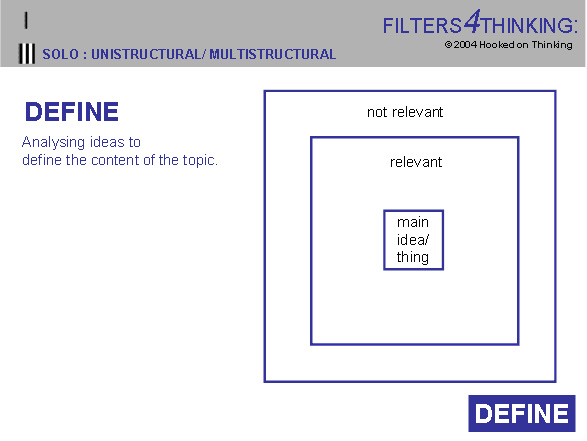Interventions and Assessment
Learning interventions

Personalisation: To be supported by the system but determined by the user.
Personalisation enables students to see themselves involved in the planning and delivery of their learning and development.
For the "user" to be thoughtfully involved in "personalisation" there must be user/student understanding of:
- The learning process
- Learning intentions and learning outcomes
- Interventions including ICTs that enhance the conditions of learning, at different stages in the learning process
- Assessing where they are in the learning process
The inquire2learn article outlines our approach to the learning process and planning for learning intentions and learning outcomes. This approach is not complete without reference to our work with students using visual intervention strategies and self assessment rubrics.
Step 3 Interventions. [Thinking skills and ICTs]
We have developed a series of visual maps (Filters4Thinking) as interventions to help students better understand the thinking at different levels of cognitive complexity. These are aligned to the common language verbs identified on the planning template.
- Visual Maps for Unistructural and multistructural thinking: Define and Describe
- Visual maps for Relational thinking: Sequence, Classify, Compare and contrast, Cause and effect, Analogy, Analysis (part whole)
- Visual maps for Extended abstract thinking: Generalise, Predict, Evaluate
Other thinking strategies and skills can be coded as thinking interventions against the learning process identified through SOLO Taxonomy. These other thinking skills facilitated interventions that enhance the conditions of value in the learning process are developed here.
The ICT facilitated interventions that enhance the conditions of value in the learning process are developed here.
Step 4 Assessment for Learning.
Student self assessment rubrics. Assessment is built into rubrics that teachers (and students) can create against each of these maps.
An example of one of the visual maps and an associated assessment rubric is given below
Students write a definition based on the ideas they have formed from the visual mapping discussion. This definition can be compared with a class definition, text book definition, ask an expert definition etc.
This statement can be self - assessed using a SOLO rubric like the example below. Students simply highlighting the criteria that best fit with their statement. Teachers can also assess the statement allowing them to determine the alignment between teacher and student assessment.
SOLO coded rubrics can be used for formative and summative assessment.
Pam Hook
June 2007


